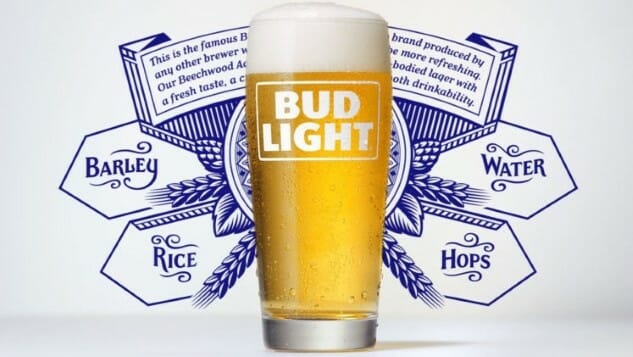Bud Light Is Putting its Nutrition Facts Front and Center with New Packaging
Images via Bud Light Drink News AB InBev
This morning, the folks over at Anheuser-Busch InBev unveiled what is, in all honesty, a pretty bold move. Beginning in February, packages of Bud Light cans will bear a brand new ingredients label, designed in the style of an FDA nutritional info box. After decades of looking the other way when it comes to the conversation of calories or ingredients in beer, the nation’s biggest-selling lager will instead be embracing a degree of transparency, and hoping that it translates to increased sales for the oft-flagging Bud Light brand. Overall Bud Light sales have decreased roughly 17 percent in the last five years.
“In every aspect of their lives, people are demanding more and more transparency,” reads the press release from AB InBev. “Bud light wants beer drinkers to have more information when it comes to choosing their brew, right at their fingertips on the packaging.”
The press release frames this as a progressive move (which it is, overall), but it also sort of smacks of Budweiser seeking press by being the first to make the move. As the AP notes, “the labels aren’t legally required, but major beer makers agreed in 2016 to voluntarily disclose nutrition facts on their products by 2020.” Bud Light will simply be the first major brand to dip a toe into these waters.
Given the increasing priority placed by drinkers on low-calorie offerings, this move could play into AB InBev’s favor. A 12 oz can of Bud Light contains 110 calories and 6.6 grams of carbohydrates, according to the new labels. That’s really not too far off from the fastest-growing brand in AB InBev’s portfolio, Michelob Ultra, which can boast only 95 calories and 2.6 grams of carbs. Given Mich Ultra’s success in the last few years as a lifestyle choice of health-conscious drinkers (it also did decently in our blind lager tasting, actually), it’s not so surprising that AB InBev would want to draw drinkers’ attention to the fact that Bud Light is also relatively low in calories.
Of course, AB InBev hasn’t completely committed to this particular course of action. They haven’t put the nutrition labels on the cans themselves (only on the package holding the cans), nor have they extended this initiative to other brands just yet. We can only presume they’re taking a wait-and-see approach for now.
It does raise the question, however, of whether we can ever expect to see such labels become a commonplace or expected feature within the world of craft beer. It’s not a great look for a company like AB InBev to be able to make the claim that they’re more transparent or forthcoming than the “little guys” who for so long defined themselves in opposition to the faceless corporate monolith of Bud. The fact of the matter is that many craft drinkers may still prefer the idea of not having to think about exactly how many calories are in each can of sugary sweet hazy IPA, but the time may come when they have no choice but to confront that knowledge. As the alcohol industry grows more health-conscious, this could prove to be a bitter pill for craft brewers to swallow, down the line.
In the meantime, look for these newly labeled Bud Lights (Miller Lite is far superior, we should probably mention) to hit store shelves in February.